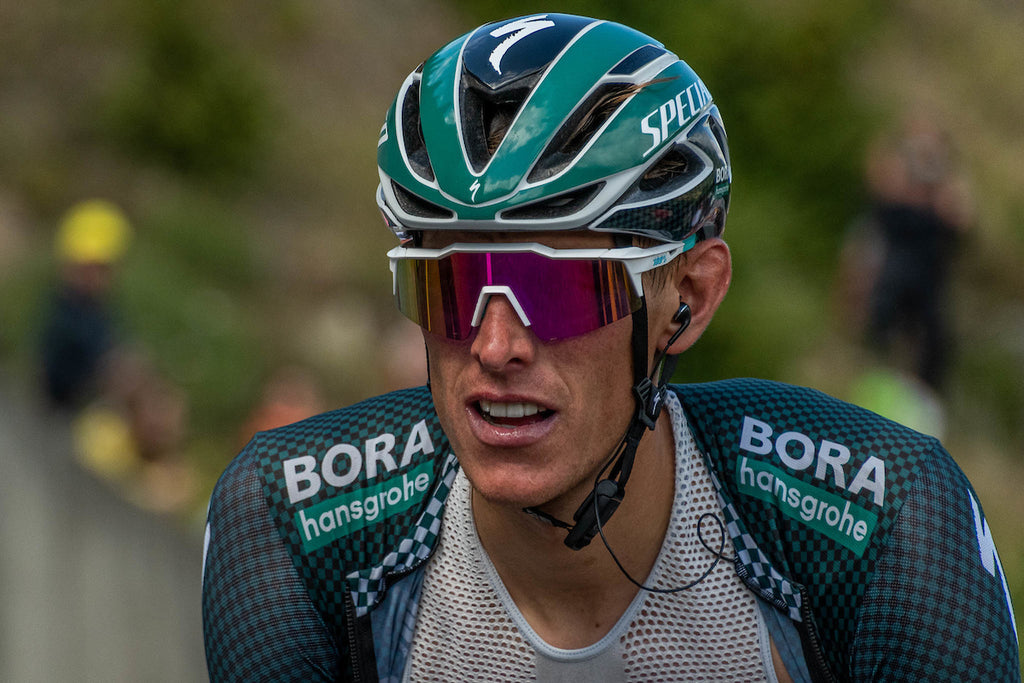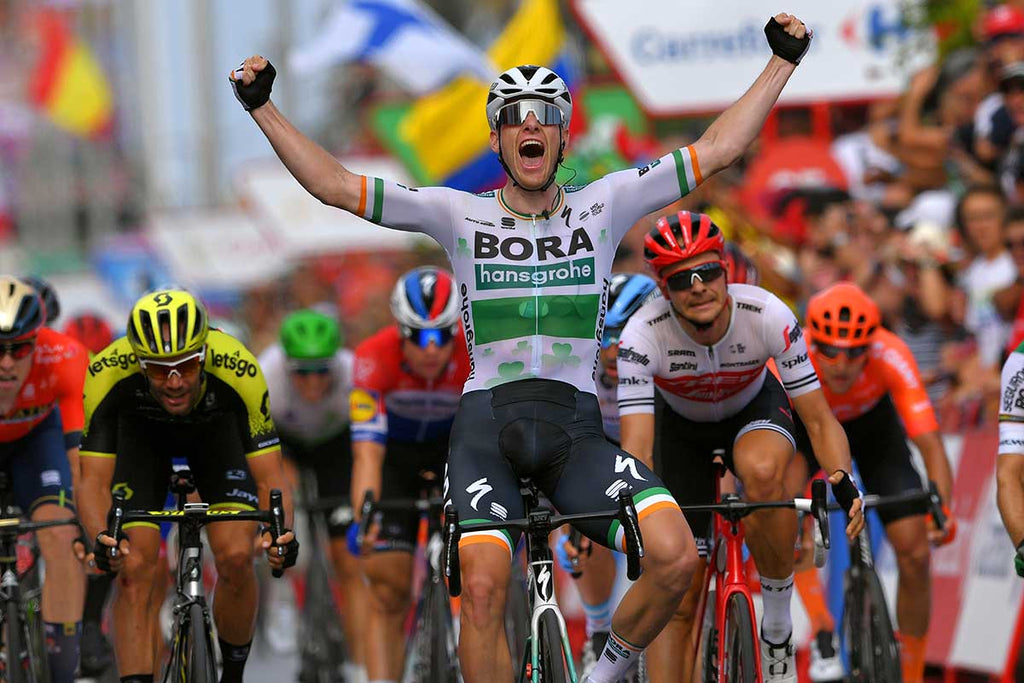Four minutes and 31 seconds, 32, 33. I keep staring at the Wahoo on my handlebars. The time passes slowly, while my heart rate is already high. Very high. 172 beats per minute and counting.
I'm not even halfway through the eight-minute FTP interval but I probably overdid it. Now I'm struggling and sweating like crazy. The room temperature is around 20°C but feels like 50 despite the fan’s max intensity and an open window. I grit my teeth and push through – I still have 10min and 3min intervals at Critical Power (highest possible average). I need to focus and embrace the pain.
What am I doing?
 Sam Bennett at BORA in 2019. The Irish sprinter has returned to the German team after a stint at Deceuninck-Quick Step. Photo: Getty Images.
Sam Bennett at BORA in 2019. The Irish sprinter has returned to the German team after a stint at Deceuninck-Quick Step. Photo: Getty Images.
A couple of weeks ago, I spotted the sub-header “Scouting” on BORA-Hansgrohe’s website, with a description of a performance test to scout young and untapped talent. As I fancied their new kit, I thought I’d give it a go. I know for sure I won’t ever lead Sam Bennett in a sprint finish nor set the tempo for Wilco Kelderman on a long climb but, physiologically, I wanted to know exactly why. Also, I don’t mind enduring a bit of pain to find the answers I'm looking for.
Related — Rouleur Performance: How UAE pro cyclists test their fitness in only three minutes.
The test
 Photo: Getty Images.
Photo: Getty Images.
As is often the case with the most brutal tests you can do on a bike, the description is a mere 10 bullet points – a hidden trap. Mind you, it's still a two-hour session, so definitely not a walk in the park. However, because of time restrictions, I had to cut down the rest time in between the intervals, which may have not played to my advantage (or at least I want to believe so). Also, I couldn’t take a day off before the test – so that's why my results aren't exactly shiny. Here’s the test:
- 30min warm-up
- 2 x 10sec full sprint with 15mins easy in between
- 20mins easy
- 30secs all-out (highest average power)
- 15mins easy
- 8mins @ FTP (on feeling)
- 10mins easy
- 10mins Critical Power (highest average power)
- 15mins easy
- 3mins CP (you can sprint for the last 30secs)
- Easy riding to cool down.
It's also important to mention that you need to take your weight the morning of the test and eat like you’d do before a race (don’t cut on carbs!). Then you need to calibrate your power meter and make sure your heart rate monitor is functioning, plus the batteries are charged. Finally, the test can be performed on a turbo trainer or outdoors, on a 6-8% climb.
Related — Rouleur Performance: Are ketones changing pro cycling?
The results
 Photo: Getty Images.
Photo: Getty Images.
Once I sent the results over to Dan Lorang, Head of Performance and Innovation at BORA-Hansgrohe, the conclusion felt like a cold shower – but I was ready for it.
"With a VO2max of 47.5mmol/min/kg, you are far away from a potential professional level," he wrote. "In these tests, we expect values that are at least 70mmol/min/kg and higher [up to 90, he says — for example George Bennett] to make the step into professional cycling."
Related — Rouleur Performance: What is Heart Rate Variability and how important is it for cycling?
My threshold power is also low (3.2W/kg) – they normally see values at around 4.9W/kg – but there was a silver lining. "With the low lactate building rate of 0.2mmol/l/s, you are probably able to keep a threshold intensity for a long time,” Lorang added. “Your strength is in constant efforts like you find in long individual time trials or in longer climbs, for example."
 Dan Lorang, BORA-hansgrohe's Head of Performance and Innovation. Photo: BORA-hansgrohe/Lukgood Studio
Dan Lorang, BORA-hansgrohe's Head of Performance and Innovation. Photo: BORA-hansgrohe/Lukgood Studio
In many ways this made sense, as my background is in long-distance triathlon. That’s what Lorang thought anyway – and he should know as, beyond coaching BORA-Hansgrohe, he also trains Ironman World Champions like Jan Frodeno and Anne Haug, plus three-time runner-up at Hawaii, Lucy Charles-Barclay. So this was good news. For my triathlon performance. But to improve in cycling, I would have to up my game in several areas.
What to improve
 Dan Lorang with Lennard Kämna at the team's training camp in Mallorca. Photo: BORA-hansgrohe/Veloimages.
Dan Lorang with Lennard Kämna at the team's training camp in Mallorca. Photo: BORA-hansgrohe/Veloimages.
The first thing Lorang suggested I improve was my VO2max. However, he clarified that there’s a scientific certainty that I would never bridge the gap with a professional. Not even if I were a young athlete – my VO2max is just too low.
"VO2max training is quite well known," he says. "On one side, you can increase your training volume. On the other hand, you can work on the VO2max area, doing intervals. You can start with 30/30 [30secs at VO2max intensity, 30secs easy] and then go up to 3/4/5mins at VO2max. This would increase VO2max and lead to better performance level and fat metabolism."
Related: Rouleur Performance. Three cycling strength mistakes, and how to avoid them.
Then there’s the other metric, the maximum lactate production rate in my muscles (VLamax). "Yours is really, really low – which is good for Ironman training – but for cycling, we would try to work on your anaerobic system to make it more powerful. So for that, we would for sure avoid having depleted carbohydrate stores and would do every training with full carb stores."
Other areas I could improve would be bodyweight and body composition. But Lorang is also clear that these would be optimisations, not game-changers.
But is it just about the numbers?
 Nils Politt at the 2021 Tour de France. Photo: Emma Wilcock/SWpix.com.
Nils Politt at the 2021 Tour de France. Photo: Emma Wilcock/SWpix.com.
Of course, if an athlete performs this test and has better numbers than me, there’s always space for new talent at BORA. “I would not say we are just using an athlete's metric like VO2max or AT to choose new riders," he said. "But we know you need a certain potential to be successful at WorldTour level."
If numbers were more in my favour (i.e. better), Lorang would have looked at my race results, training data and history and then maybe we would have had a call. But there’s more than just the physiological aspect. They also need to understand a rider’s personality and if the athlete would fit into the team’s culture and roster.
Related — Rouleur Performance: Elisabetta Borgia, team Trek-Segafredo's sport psychologist.
Gateway to BORA-Hansgrohe
 Lukas Postlberger at the 2021 Dauphiné. Photo: CorVos/SWpix.
Lukas Postlberger at the 2021 Dauphiné. Photo: CorVos/SWpix.
BORA has been using this performance test for four years and every rider who joins their team – or who would like to – has to go through the 2hrs of pain. The test gives them some numbers to compare different riders and understand their physiology.
Something they already know is that riders prefer to execute the test outdoors, hence the tailored protocol that can be done on a climb. “Outdoors it’s more realistic,” said Lorang. "The first interval is a threshold interval where you can get some calibration on body feeling and values, then we have a 10min peak power testing and 3min power, and these numbers give an idea on threshold and VO2max. From these two, we can calculate the VLamax."
After the test, they still compare the results with the individual's lab or lactate tests to gather more insight.
Related — Rouleur Performance: Long and steady or short and sharp? That's the winter conundrum.

I won't be leading Sam Bennet to a sprint this season, but who knows? Maybe next year? Photo: Getty Images.
Although none of the current BORA riders have come from the online scouting page, one of their riders, Danish track specialist Frederick Wandahl, did the performance test during the recruiting process and his good results were one important piece of the puzzle to sign him in the end.
The goal of that page, Lorang concluded, is still to find an exceptional athlete. "It takes a lot of work and chance [to find one]. But if you have a good system in place, you can raise the possibilities to find a special athlete, who can be successful and fit, physically and mentally, into our team.”
Related — Rouleur Performance: Chasing Ventoux. Rouleur's complete 12-week programme
And even though I know I won’t be joining BORA in 2022, at least I also know why. On the contrary, if you think you have more of a chance than I do, you can apply and try your luck by heading to their page here.
Cover image by Michael Steele/Getty Images






























